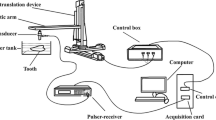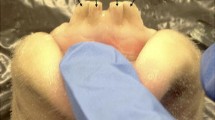Abstract
Ultrasound transmission velocity (UTV) in isotropic material as a measure for the modulus of elasticity was correlated to mechanical properties. Changes in micromechanical properties of radiated teeth and influence of the oral cavity were to be evaluated nondestructively. UTV was measured in extracted teeth after 36 Gy and 62 Gy of in situ (enorally, with no contact to the oral cavity) and in vitro irradiation. Relative to controls, teeth subjected to 62 Gy in vivo showed higher UTV values for dentine and enamel. Sound teeth irradiated with 60 Gy in situ also showed higher UTV values for enamel, whereas dentine values were not significantly different from those of control. The mechanical properties of teeth irradiated in vitro were affected only after high experimental doses of up to 500 Gy. The difference between in vivo and in vitro mechanical properties may be due to radioxerostomia-induced damages as well as the status of dentine vitality. This supports the concept of direct radiation-induced damage in synergy with radioxerostomia-induced caries.
Similar content being viewed by others
Author information
Authors and Affiliations
Additional information
Received: 20 December 1999 / Accepted: 13 March 2000
Rights and permissions
About this article
Cite this article
Al-Nawas, B., Grötz, K., Rose, E. et al. Using ultrasound transmission velocity to analyse the mechanical properties of teeth after in vitro, in situ, and in vivo irradiation. Clinical Oral Investigations 4, 168–172 (2000). https://doi.org/10.1007/s007840000068
Issue Date:
DOI: https://doi.org/10.1007/s007840000068




